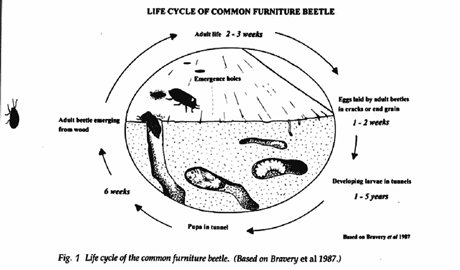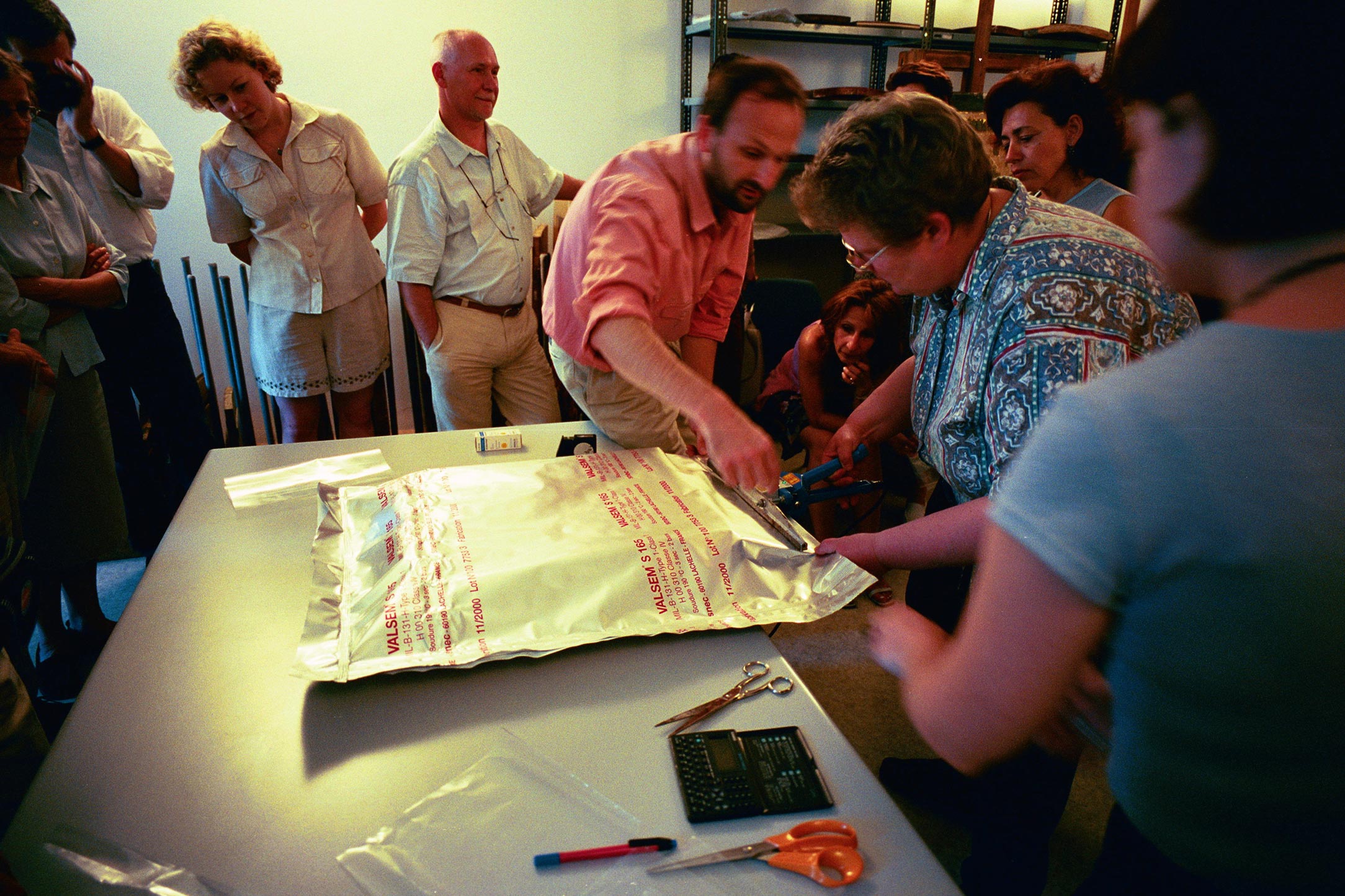
By Alain Renard, 2001
Anoxia desinfection

Wednesday 4 March 2009, by Icon Network
All the versions of this article:
- [English]
- [français]
The insects in the artifacts
The wooden objects are the major source of food for the Iarvas of the woodworms. We can meet several categories of insects who damage the wood and infestate the artifacts such as the termites, beetles (coleoptera) etc. Insects are unable to regulate their own temperature and this can be of major importance in limiting or preventing problems.
But how an attack is occurred?
Common furniture beetle or woodworm Anobium punctatum is widespread in most temperate countries and is present in many houses and buildings and furniture. The life cycle is shown in figure 1.

- Shema 1
Adult beetles (3 – 5 mm long) emerge during the summer months by grawing circular exit–holes 1,5 – 2 mm diameter in the wood. As they fly away, wood dust and larval exreta (frass) may fall out of the hole leaving a caracteristic sign of active beetle infestation – small piles of fresh dust. After the beetles have mated, the female lays eggs in crevices in the wood particularly in end grain, unplaned timber or old exit holes.
The eggs hatch in a few weeks, the larval tunnel into the wood and as they grow, the size of the tunnel increases. The larval take 2 or 3 years to complete development to adult depending upon the type of wood and the conditions of temperature and moistrure content. Anobium infestations will survive in cool, damp conditions but do not thrive in very dry conditions and humidities below 50%. Will prevent serions damage, although unfortunately this may also cause drying out and deterioration of wooden artifacts.
Signs of an infestation
When we ovserve an infestated artifact we must try to see if there are « mountains » of frass around the holes or fresh frass around the object withour having moved it. The interior of the holes must look new and have the colour of a recent cut wood.
A specific equipment exist for the diagnosis of an infestation. They are called « acoustic » and they permit to situate the larval activity in the wood. We can refer to the INADEC acoustic detection machine giving comparisson references or the TERMATRAC, micro – wave Doppler detection machine. What is important to do in any stage of insect development is to stop the proliferation. For that the conservator can choose many methods.
The existing methods
Impregnation of the wood by liquid agents – like organochlorine (OC’s) – Lindane, DDT, Dieldrine, Gamma – BHC etc, the organosphorus (OP’s) pyrethroid and numerous commercial products like xylophene, xylamon – LX. Those products are extremely toxic, they are used for residual treatment and they are extremely persistent in the environment. The application of any persistant pesticide directly to objects will leave residues of that chemical or its breakdown products. Wood treatment are designed to be applied directly to the material needing treatment or protection and some insecticides and formulations are particularly effective. However, the need for protection must be balanced against the deliberate contamination of objects with chemicals which will produce long term residues and may after the chemistry or appearance of objects.
Fumigation – Museums and important conservation centres use this method. Objects may be fumigated under gas–proof sheets or in specially built or modified chambers. The fumigants used are Ethylene Oxyde ((CH2)20), methyl bromide (CH3Br). Those fumigants are extremely toxic and their use is going to be restricted in many countries by complex safety regulation. The effect of fumigant gaes and consequent residues on objects give couse for concern. Extensive airing – of periods are needed in order to disperse traces of gas which have been absorbed by the fumigated goods.
Other physical methods have been applied like micro–wave radiation, gamma radiation, heating (Thermolignun), freezing. All those methods are curative or preventive but all of them present counter–indication. The Anoxia treatment Various research have been elaborated for creating inert atmosperes, which means an atmosphere without oxygen.
The existing methods are :
![]() the static treatment using oxygen scavengers,
the static treatment using oxygen scavengers,
![]() the dynamic treatment (replacement of the oxygen by a humidified inert gaz: azote, Co2, argon…)
the dynamic treatment (replacement of the oxygen by a humidified inert gaz: azote, Co2, argon…)
![]() the mixed treatment, combining the two previous methods.
the mixed treatment, combining the two previous methods.
The choice of the method (static, dynamic or mixed) depends on the volume we have to treat. In this meeting we present the method that suits more to the treatment of the icons, demanding not a big equipment and is the stratic whith the use of oxygen scowengers.
The static anoxia
The oxygen reduction from the air is obtained by absorption. The oxygen scavergers are sachets containing Iron powder, sulfur, a saturated solution of sea salts and zeoliths. Through the contact of the air an electrochemical reaction is produced the Iron is oxydated under the action of the humidity and the electrolyte.
In the beginning of the reaction we can observe an augmentation of the temperature and of the R.H. It is important not to open the packets containing the oxygen scavengers before having prepared everything for the treatment. It is better to put them in the last minute before sealing the plastic bag containing the object.
The second factor is the calculation of the quantity of Oxygen Scavengers for a sealed object. After determining the approximate volume of the bag, (V=length en cm X width in cm X hight cm) knowing that the level of oxygen in the air is 20,9% we have to say that the relation between the volume of air V and the volume of oxygen contained in a certain volume of air is 5.We have to divide the volume of air by 5.
Vo = V/5
Knowing the capacity of absorption of each oxygen scavenger we can calculate the number of sachets needed by dividing Vo by this capacity.
For example Ageless Z – 2000 has a capacity of 2000 cc, while ageless Z – 1000 capacity of 1000 cc.
Once we have determined the number of sachets we must put them in the enveloppe placing them around the object because the sachets during the treatment present an exothermic reaction and they become very hot.
The choice of the high barrier packaging film depends on the permeability needed. We have the choice of different transparent films or aluminium foils.
It is important to control constantly the level of the oxygen in the bag and for that we have the following ways :
![]() The rose pills "Eye" by Mitsubishi,
The rose pills "Eye" by Mitsubishi,
![]() The blue strips by Merck,
The blue strips by Merck,
![]() An electrochemical cellular oxymetre.
An electrochemical cellular oxymetre.
Necessary materials
Oxygen scavengers/rapid action
Ageless–Z (Mitsubishi Gas Chemical Company)
ATCO LH ou HV (Standa Industrie)
68, rue Robert Kaskoreff
14 050 Caen Cedex France
Fax 00 33 – 2 31 73 13 57
Phone 00 33 – 2 31 74 54 89
http://www.standa.com
standa@mail.cpod.fr
Plastic enveloppe / film aluminium
VALSEM S 165 (ASNEC), permeability between 0,1 et 0,2 cm3 / m2 / 24h / 1atm
Aclar (polychlorofluoroethylene); Cryavac (Polyvinyliadine chloride)
Rentokil Corporation.
A heating sealer
An oxymeter or other oxygen indicators
![]() MITSUBISHI, (Ageless),
MITSUBISHI, (Ageless),
![]() Merck (blue strip),
Merck (blue strip),
![]() les oxymètres (agro–alimentaire, Abyss, Pak).
les oxymètres (agro–alimentaire, Abyss, Pak).
A thermohygrometer
P.S.
Consultation : Anoxia bibliography
And you can also download the full pdf (411 pages - 17 Mb). You can accept the full screen mode when you open the pdf, and exit by using the Escape key. If you don’t do as described below, the pdf will be displayed in normal mode.
Attached documents
-
Full Vicenza PDF (Zip - 17 Mb)European Culture Project, Palazzo Leoni Montanari, Vicenza, 2001


















